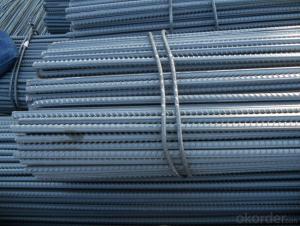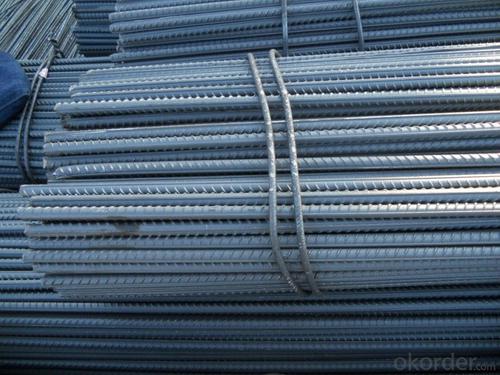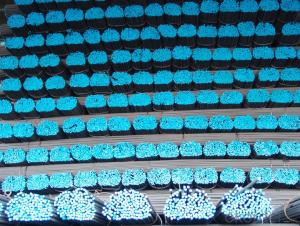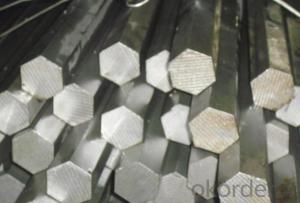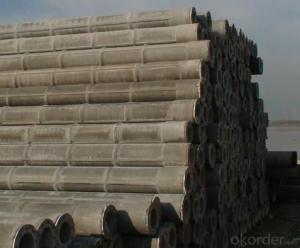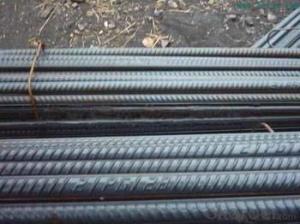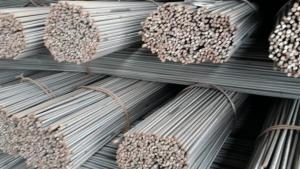Deformed bars Hot Rolled with High Quality and Good Price
- Loading Port:
- Tianjin
- Payment Terms:
- TT OR LC
- Min Order Qty:
- 25 m.t.
- Supply Capability:
- 10000 m.t./month
OKorder Service Pledge
OKorder Financial Service
You Might Also Like
Product Description:
OKorder is offering high quality Hot Rolled Rebars at great prices with worldwide shipping. Our supplier is a world-class manufacturer of steel, with our products utilized the world over. OKorder annually supplies products to Africa, North American and Asian markets. We provide quotations within 24 hours of receiving an inquiry and guarantee competitive prices.
Product Applications:
Deformed bar is widely used in buildings, bridges, roads and other engineering construction. Big to highways, railways, bridges, culverts, tunnels, public facilities such as flood control, dam, small to housing construction, beam, column, wall and the foundation of the plate, deformed bar is an integral structure material. With the development of world economy and the vigorous development of infrastructure construction, real estate, the demand for deformed bar will be larger and larger..
Label: to be specified by customer, generally, each bundle has 1-2 labels
Product Advantages:
OKorder's Hot Rolled Rebars are durable, strong, and resist corrosion.
Main Product Features:
· Premium quality
· Prompt delivery & seaworthy packing (30 days after receiving deposit)
· Corrosion resistance
· Can be recycled and reused
· Mill test certification
· Professional Service
· Competitive pricing
Product Specifications:
Manufacture: Hot rolled
Grade: HRB400 – HRB500
Certificates: ISO, SGS, BV, CIQ
Length: 6m – 12m, as per customer request
Packaging: Export packing, nude packing, bundled
Grade | Technical data of the original chemical composition (%) | ||||||
C | Mn | Si | S | P | V | ||
HRB400 | ≤0.25 | ≤1.60 | ≤0.80 | ≤0.045 | ≤0.045 | 0.04-0.12 | |
Physical capability | |||||||
Yield Strength (N/cm²) | Tensile Strength (N/cm²) | Elongation (%) | |||||
≥400 | ≥570 | ≥14 | |||||
Theoretical weight and section area of each diameter as below for your information:
Diameter(mm) | Section area (mm²) | Mass(kg/m) | Weight of 12m bar(kg) |
6 | 28.27 | 0.222 | 2.664 |
8 | 50.27 | 0.395 | 4.74 |
10 | 78.54 | 0.617 | 7.404 |
12 | 113.1 | 0.888 | 10.656 |
14 | 153.9 | 1.21 | 14.52 |
16 | 201.1 | 1.58 | 18.96 |
18 | 254.5 | 2.00 | 24 |
20 | 314.2 | 2.47 | 29.64 |
22 | 380.1 | 2.98 | 35.76 |
25 | 490.9 | 3.85 | 46.2 |
28 | 615.8 | 4.83 | 57.96 |
32 | 804.2 | 6.31 | 75.72 |
36 | 1018 | 7.99 | 98.88 |
40 | 1257 | 9.87 | 118.44 |
50 | 1964 | 15.42 | 185.04 |
FAQ:
Q1: Why buy Materials & Equipment from OKorder.com?
A1: All products offered byOKorder.com are carefully selected from China's most reliable manufacturing enterprises. Through its ISO certifications, OKorder.com adheres to the highest standards and a commitment to supply chain safety and customer satisfaction.
Q2: The products are invoicing on theoritical weight or on actual weight?
A2: We can do it in both manners, according to the customers' request.
Q3: How soon can we receive the product after purchase?
A3: Within three days of placing an order, we will begin production. The specific shipping date is dependent upon international and government factors, but is typically 7 to 10 workdays.
Images
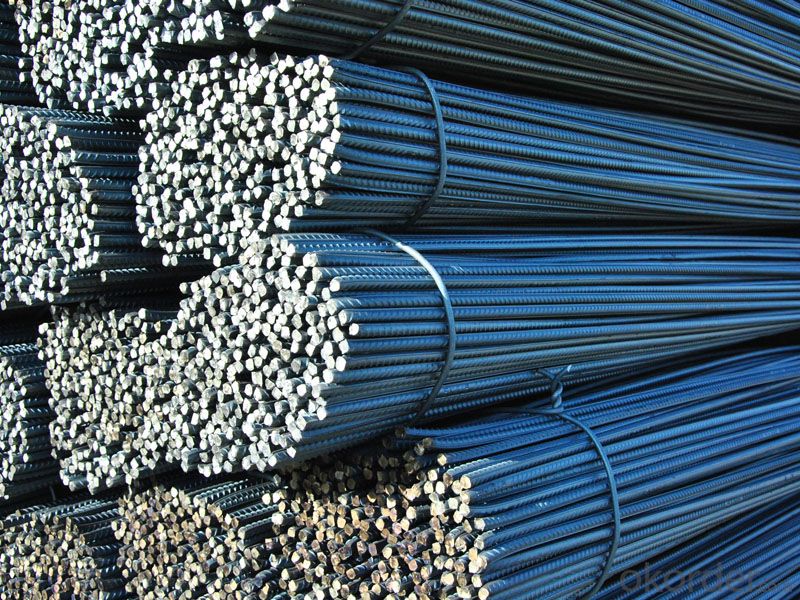

- Q: Can steel rebars be used in structures exposed to extreme temperatures?
- Yes, steel rebars can be used in structures exposed to extreme temperatures. Steel has high thermal conductivity, which allows it to transfer heat quickly, minimizing the risk of structural damage due to thermal expansion or contraction. However, it is essential to consider the specific temperature range and the potential impact on the structural integrity of the rebar. In extremely high temperatures, other materials or protective measures may be necessary to ensure the stability and safety of the structure.
- Q: Can steel rebars be used in tunnels and underground structures?
- Yes, steel rebars can be used in tunnels and underground structures. They are commonly used to reinforce and strengthen the concrete used in these structures, providing additional stability and load-bearing capacity.
- Q: What are the different types of steel rebars used in retaining wall constructions?
- There are several types of steel rebars commonly used in retaining wall constructions, including plain carbon steel rebars, epoxy-coated rebars, galvanized rebars, and stainless steel rebars. Each type has its own unique properties and benefits, such as increased corrosion resistance or enhanced durability, allowing for the selection of the most suitable option based on the specific requirements of the retaining wall project.
- Q: How do steel rebars affect the overall seismic performance of a structure?
- Steel rebars play a crucial role in enhancing the overall seismic performance of a structure. Seismic events such as earthquakes exert dynamic forces on buildings, causing them to vibrate and potentially collapse. However, the inclusion of steel rebars in concrete structures significantly improves their ability to withstand such forces and ensures the safety of the occupants. Firstly, steel rebars enhance the structural integrity of a building. By reinforcing the concrete, they increase its tensile strength, as concrete alone is weak in tension. During an earthquake, the rebars help distribute the dynamic forces throughout the structure, preventing the concentration of stress on specific areas. This redistribution of forces minimizes the risk of localized failures and ensures that the structure remains stable. Furthermore, steel rebars increase the ductility of the structure. Ductility refers to a material's ability to deform under stress without fracturing. During an earthquake, buildings experience significant lateral movements and deformations. Steel rebars, due to their high ductility, can elongate and stretch without breaking, absorbing and dissipating the seismic energy. This property allows the structure to withstand larger ground motions and reduces the possibility of sudden collapse. Additionally, steel rebars improve the overall resilience of a structure. Resilience refers to the ability of a building to quickly recover its functionality after an earthquake. By reinforcing the concrete, steel rebars contribute to the post-earthquake repairability of the structure. They ensure that the building maintains its load-carrying capacity even after suffering damages, which reduces downtime and allows for faster recovery. Moreover, steel rebars provide a warning sign of potential structural issues. During an earthquake, cracks may appear in the concrete, indicating areas of stress concentration. These cracks are often visible around the rebars, serving as an early indication of structural vulnerability. This visual warning allows for timely inspection and repair, preventing further damage and ensuring the long-term safety of the building. In conclusion, steel rebars play a vital role in enhancing the overall seismic performance of a structure. Their inclusion in concrete significantly improves the structural integrity, increases ductility, enhances resilience, and provides visual warnings of potential issues. By reinforcing the concrete, steel rebars ensure that buildings can withstand seismic forces, reducing the risk of collapse and ensuring the safety of occupants during earthquakes.
- Q: What is the typical lifespan of steel rebars in different climates?
- The typical lifespan of steel rebars can vary depending on the climate conditions. In general, rebars can last for several decades in moderate climates with low humidity and minimal exposure to corrosive elements. However, in more extreme climates with high humidity, saltwater exposure, or severe temperature fluctuations, rebars may experience accelerated corrosion and have a shorter lifespan. Regular maintenance and proper corrosion protection measures can help extend the lifespan of rebars in different climates.
- Q: What is the process of welding steel rebars together?
- The process of welding steel rebars together involves heating the ends of the rebars using an electric arc or oxy-fuel flame until they reach a molten state. Once molten, the rebars are pressed together and fused to form a solid and continuous joint. This process is known as rebar welding and is commonly used in construction to reinforce concrete structures.
- Q: What is the process of inspecting steel rebars for quality control?
- The process of inspecting steel rebars for quality control involves several steps to ensure that the rebars meet the required standards and specifications. Here is a general overview of the process: 1. Visual Inspection: The first step is to visually inspect the rebars for any visible defects such as cracks, surface imperfections, or irregularities in shape or size. This can be done manually or using automated systems that detect defects through image processing techniques. 2. Measurement and Dimensional Inspection: The rebars are then measured for their dimensions, including length, diameter, and shape. This is typically done using calibrated measuring instruments such as calipers, gauges, or laser-based devices. The measurements are compared against the specified tolerances to ensure compliance. 3. Chemical Analysis: A sample of rebars is taken and subjected to chemical analysis to determine the composition of the steel. This includes measuring the levels of carbon, manganese, sulfur, phosphorus, and other elements. The results are compared against the required chemical composition specified in the standards. 4. Mechanical Testing: Mechanical properties such as tensile strength, yield strength, elongation, and bendability are crucial for rebars used in construction. Samples are taken from the batch and tested in a laboratory using standardized tests, such as tensile testing machines, to ensure they meet the specified requirements. 5. Corrosion Resistance Testing: Rebars are often exposed to harsh environmental conditions, so it is important to assess their resistance to corrosion. This can be done through tests like salt spray testing or electrochemical methods to measure the rebars' corrosion resistance and ensure they will maintain their strength over time. 6. Weldability Testing: If rebars are intended for welding applications, their weldability is assessed. This includes evaluating the rebars' ability to form a strong and sound weld joint without any defects. Weldability tests may involve visual inspection, bend tests, or even destructive testing of welded samples. 7. Documentation and Certification: Throughout the inspection process, detailed records of all measurements, test results, and observations are documented. If the rebars pass all quality control tests, a certification or quality control report is issued, indicating that the rebars meet the required standards and specifications. It is worth noting that the specific inspection procedures may vary depending on the applicable standards, project requirements, and the type of rebar being inspected. Additionally, these inspections can be conducted by internal quality control teams or independent third-party inspection agencies to ensure impartiality and accuracy of the results.
- Q: How are steel rebars protected from theft during construction?
- Steel rebars are commonly protected from theft during construction through various security measures. These may include storing them in locked and secured areas, implementing surveillance systems, using GPS tracking devices, employing security personnel, and maintaining strict inventory management. Additionally, marking the rebars with identification numbers or unique markings can also help deter theft and aid in recovery efforts if stolen.
- Q: How do steel rebars contribute to the structural integrity of a building?
- Steel rebars, also known as reinforcing bars, play a crucial role in enhancing the structural integrity of a building. These bars are embedded within concrete structures, such as beams, columns, and slabs, to provide tensile strength and prevent cracking or failure under load. By reinforcing the concrete, steel rebars help distribute and resist the forces acting on the structure, ensuring its stability and durability.
- Q: How are steel rebars protected during concrete pouring?
- Steel rebars are typically protected during concrete pouring by using a layer of epoxy coating or corrosion-resistant paint. This protective layer acts as a barrier between the rebar and the concrete, preventing direct contact and reducing the risk of corrosion. Additionally, plastic or foam covers can be used to shield the rebars from the wet concrete, ensuring proper adhesion and preventing damage during the pouring process.
Send your message to us
Deformed bars Hot Rolled with High Quality and Good Price
- Loading Port:
- Tianjin
- Payment Terms:
- TT OR LC
- Min Order Qty:
- 25 m.t.
- Supply Capability:
- 10000 m.t./month
OKorder Service Pledge
OKorder Financial Service
Similar products
Hot products
Hot Searches
Related keywords
